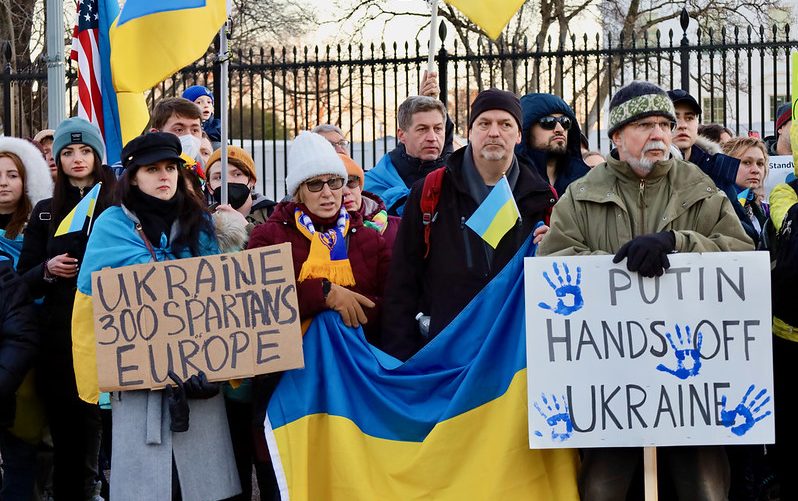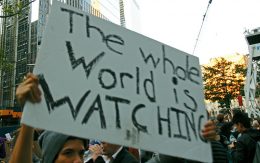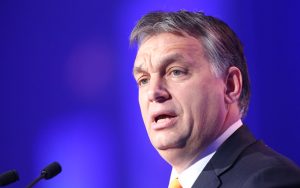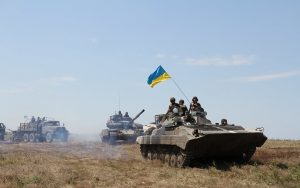The conflict in Ukraine has sparked many debates on several issues, from military and political to ideological ones. There are numerous narratives and theories linked to Putin’s decision to invade Ukraine, this fiercely contested portion of Russia’s near abroad. Among these, there are the discourses centered on Eurasianism, which provide the Russian elites with strong arguments for the invasion, at least on an ideological level.
Contemporary Eurasianist ideas flourished in the 1990s in several political and cultural circles after the dissolution of the Soviet Union. Accordingly, all elaborations and philosophies concerned with it are the reshapings of specific ideas elaborated in the 1920s by Russian emigres in the USA. Their need was to make sense of Russia’s identity on the morrow of the Bolshevik revolution through a new doctrine able to provide, in the attempt to avoid old imperial practices, an alternative to the Bolshevik ideology. Its core concept was the preservation of the multi-ethnic nature of the wider Eurasian region, made possible through the concept of “symphonic personality,” linking together different peoples based on geography (Kivelson & Suny, 2017).
This elaboration attempted to address the old problems of the imperial era through the promotion of Russians as the greatest of the Slavs and concepts like brotherly love as the basis of the overall Eurasian idea. One essential Eurasianist tenet was the critic of the Petrine era, accused of watering down the authentic Russian values by adopting the Western culture, an idea shared by the 19th century Slavophiles (Ibid.: p. 162). What differentiates the Eurasianists from the Slavophiles is the adoption of non-Slavic elements to account for the multi-ethnic character of the region that encompasses many different ethnic groups, especially Turkic ones. This was a breakthrough since, until then, the inclusion of other groups was rejected based on European colonialist and civilizational ideas. These did not account for the high variety of ethnic groups, turning, therefore, the former Russian empire into a “sui generis” supranational entity named Eurasia (Torbakov, 2015).
What’s fascinating about this concept’s long journey from the early 1900s to today is the re-shaping of its core assumptions. From a theory that would provide the inhabitants of the former and geographically endless Russian empire with a new idea of the nation-state to an effective narrative for economic expansion. This transition happened in the early 1990s when a politicized theory known as Neo-Eurasianism was developed to support Russian foreign policy goals rather than to reaffirm the idea of brotherly nations that had been preached previously. This occurred because the new Eurasianists’ route significantly altered the concept of cultural identity and historical ties in the large Eurasian region.
This is not surprising, given that, as Marlene Laruelle points out, Eurasianism is a very flexible concept that encompasses a wide range of ideas: a strict political doctrine, an ethnogenesis theory, a globalist philosophy of history, and a set of geopolitical principles largely exploited by Russia in the formulation of its foreign policies, which explains its success from the nineteenth century to the present (Dixon Klump, 2011).
Eurasianism and Neo-Eurasianism were primarily concerned with the concept of a new geographical identity based on the binomen Russia-Eurasia, which was applied to a variety of sectors, including politics and science. Nonetheless, this occurred without a clear commitment to the development of a unified political theory (Silvius, 2014). Laruelle wisely draws on Samuel P. Huntington’s concept of the clash of civilizations when it comes to Eurasianism. This concept helps explain how the major source of disputes is the immutable character of civilizations, rather than economic or political goals. When applied to the Eurasian region, this translates to the Western model’s inability to handle and explain the region’s idiosyncrasies (Laruelle, 2008).
These concerns were discussed in the pre-Eurasian debate in the nineteenth century, long before the Eurasian concept was conceived. The primary topics of discussion in this debate were the effects of Russia-Asia contacts, and the role played by the former. The question was whether Russia should be regarded as a beacon of European civilization in the direction of the Orient or as a part of the Orient itself. As a result, history should not be lost, and the Mongol period’s function as a maker of the Russian mindset should be reconsidered, given their close ties. The Mongol conquest of the Rus, which is often viewed negatively, should be rethought as a good source of political strategy for how to rule through difference by granting local élites and populations some degree of autonomy and enriching the center through taxation (Kivelson & Suny, 2017: p 41). This ensured, and this is the basic foundation of the Eurasianist movement, that Russia should not be considered the periphery of Europe because, due to the combination of Slavic and Turco-Muslim characteristics, it holds a midway position between Europe and Asia. Other essential assumptions include cultural unity, a common historical destiny for all Eurasian peoples, rejection of the West, capitalism, and Atlanticism, and the geographical notion that the Eurasian median position necessitates a centralized government, making any kind of secession unattractive (Dixon Klump, 2011).
Despite its name, the Eurasianist concept also emphasizes the importance of eastern Europe and the strategic location of countries like Ukraine. The word “geography” is crucial. In his 1904 Heartland Theory, British geographer Sir Halford Mackinder described its significance. As a result of the relative collapse of maritime power, he defined the heartland as the territory including interior Asia and eastern Europe, the so-called “World Island”. According to the Heartland theory, a country that can rule Eastern Europe can also control the Heartland and the World Island (Loy, 2018).
This theory’s six basic components are still applicable today as they were back then. The first two are geographical resource distribution and proximity. The latter refers to a power’s ability to extend its impact to nearby areas, as its might is felt significantly more in proximity than in faraway areas. This leads to the third factor: interconnectedness. The fourth aspect requires the combination of opposing colors to map out the numerous civilizations that inhabit the region. This emphasizes the area’s inherent homogenous structure but also its several differences when compared to one another. The fifth element is the clash of cultures, derived directly from the previous one. Finally, there is the concept of exceptionalism, given that only one civilization will emerge as the carrier of universal ideals in this multifaceted mosaic (Kearns, 2013).
These six aspects will appear in every elaboration of major Eurasianists and Neo-Eurasianists as the explanation for their philosophical, scientific, or political doctrines, and they are relevant to the current situation in Ukraine.
In this aspect, Tolzs’s explanation of Russian identity is useful in comprehending the Eurasianist approach to Ukraine, which is intricately linked to other notions and narratives espoused by Russia’s ruling elites (Tolz, 1998). He points out that, after the dissolution of the Soviet Union, Russian elites offered five possible ways of seeing Russian identity. The first concerned the very nature of the Russians, defined as “an imperial people or through their mission to create a supranational state”, implying that from a territorial point of view, Russians should not be confined to a limited Russian state but instead control a larger chunk of territory (Eurasia). The second one considers Russians as the elected ethnic group of all eastern Slavs, putting emphasis on ethnocultural similarities and the common past. Based on this, Ukraine and Ukrainians are just a branch of Russia. The third identity highlights both the Russian language and the Orthodox religion as unifying factors and strong ethnic markers of all eastern Slavs. The fourth one, taking a more scientific direction, states the importance of blood ties as the main factor in creating an identity that would include, in equal parts, both Russians and Ukrainians. The fifth and last identifies Russia as a civic nation, encompassing all citizens of the Russian Federation.
The first four identities contribute to creating and supporting the idea of a non-existent Ukrainian state since its territory and people are considered an integral part of Russia. Accordingly, a useful narrative is that of Novorossija (New Russia). This ambitious project is based on the idea that Ukrainians are faithful more to the idea of the Russkij Mir (Russian World), founded by President Putin in 2007, than to Ukrainian patriotism, which echoes the first four identities outlined earlier. Putin confirmed this attitude in his April 2008 speech at the NATO-Russian Council at the Bucharest NATO summit, where he described Ukraine as a fragile and artificial construct. He doubted Ukraine’s right to control Russian-speaking eastern and southern Ukraine since “seventeen million Russians currently live in Ukraine”. Who is to say that we have no interest in the south of Ukraine, completely, there are only Russians” (Putin, 2008). Russian territorial claims primarily target the Novorossiya oblasts of Donetsk, Luhansk, Kharkov, Dnipro, Zaporizhya, Odesa, Mykolaiv, and Kherson (Taras, 2019). This is not a coincidence, given that, as previously stated, whoever controls Eastern Europe controls the heartland.
The Ukrainian question within the Eurasian project is not new. It was raised in the 1920s by one of the first Eurasianists, Russian émigré prince Nikolaj Trubetzkoj. In his view, Communism was a western-imported ideology that was ineffective for Russia. What instead would provide cohesion across the vast Eurasian area would be Russian Orthodoxy, whose exponents would also care for believers of other faiths. In this regard, Ukrainian culture was an obstacle to the realization of this endeavour, as it would lead to the individualization of all-Russian culture. This meant that Ukrainians, as well as Belarussians, should all gather around Russians, with Orthodoxy as the main pivot (Burbank, 2022).
The four identities mentioned earlier, the Orthodox faith, and the Ukrainian problem represent the basis of the new Eurasianist concept formulated by Alexandr Dugin, professor of Sociology at Moscow State University and journalist dissident since 1988. He was both inspired by and critical of the fathers of Eurasianism. If, on the one hand, he acknowledged the importance of the third continent concept as well as the Mongols in shaping Russian identity, he also acknowledged their failure to theorize their ideas consistently (Laruelle, 2006). He entrusted himself, therefore, with the mission of providing Russia with a comprehensive and consistent theory of world order, elaborated in his work Foundations of Geopolitics: Russia’s Geopolitical Future, where he exposes his own theory of world order with the aim of creating a new national idea to support both the executive and legislative power (Ibid.: 3). In this text, he makes clear that Ukraine’s sovereignty is a danger to all of Eurasia because of its subjection to Atlanticism. Subsequently, total military control over the Black Sea, as well as reducing Ukraine to an administrative sector of Russia, is an imperative for Russia because, in his view, Ukraine has no geopolitical, geographic, or ethnic relevancy (Dugin, 1997). President Putin took notice of this concept, openly declaring in 2013 the link between the Eurasian zone and the Russian genetic code and that this vast area should be protected from western expansionist claims. But even more recently, in the speech addressed to the nation on February 21, this year, he reminded us that Russians and Ukrainians are one people, that Ukraine is a colony with a puppet government and, therefore, an extremely weak link prone to being influenced by the West. Moreover, he adds, the Orthodox Church is at stake because it is under assault by NATO (Putin, 2022). Dugin well accounts for the eastern-western clash, echoing Samuel Huntington’s, in the struggle between land-based Eurasianists and sea-based Atlanticists, or, in other words, between profit-driven America and the Orthodox stronghold in Russia (Tsygankov & Tsygankov, 2010). His debt to Mackinder’s Heartland is relevant. The geographer stated in 1943 that the territory of the USSR was equivalent to the Heartland (Mackinder, 1943), offering a breeding ground for a re-elaboration of the Eurasianist-Atlanticist relationship. This is reinforced by Dugins’ formulation of Russia acquiring the ability to defend its Eurasian territory at the turn of the twentieth century, signalling the end of Western Sea expansionism and the proclamation of Eurasia as the heartland where civilization’s future would be decided (Silvius, 2014: p. 54). Accordingly, Dugin attempts to link the Karaganov doctrine, supporting the idea of Russia’s intervention in its “near abroad” to protect the collective rights of ethnic Russians, with his own philosophical ideas. Accordingly, he implemented a shift from Karaganov’s realist and statist viewpoints, promoting the maximization of Russia’s interests in the post-Soviet space to a broader structure that contemplates other actors in international politics (Petsinis, 2014).
Dugin is adamant that Russia must reclaim its Great Space in order to safeguard all of the peoples who live there, based on a special concept of Russian nationalism in which Russians must first acknowledge themselves as Orthodox, then as Russians, and finally as individuals (national self-identification over self-identification). The Orthodox Church is the essential principle that leads to the integrity and unity of the Russian ethnic organism in order to create a new sense of nation that is perceived as “the church” and individuals who are initially defined as “Orthodox” (Dugin, 1997: p. 255-256). This re-elaborated Eurasian concept, with its emphasis on Orthodoxy and Russian ethnic superiority, will thereby present the globe with an alternative to unipolar, Western globalization. This is compounded by the employment of civilizational language based on the cultural affinities of the region’s ethnic groups by political elites to disguise political, military, and economic projects.
When speaking of the mission and moral obligation handed to Russia, Putin leaned on this civilizational narrative: “our involvement is fitting, wanted and needed” (Putin, 2016), which is perfectly consistent with the Eurasianist notion of a preset Russian superior role based on a strong geographical and cultural component. Nonetheless, he makes a subtle move from the cultural to the economic sphere by stating that the “quality and the size of the Russian economy must be consistent with [Russia’s] geopolitical and historical role” by stressing the concept of responsibility towards all regions (Putin, 2014).
In Ukraine, the Kremlin consolidated this cultural, geographical, and economic trinomial approach. Putin’s concept of the Russian World, which he announced in 2007, was used to carry out soft power activities in the country. This concept is similar to and overlaps with the Moscow Patriarchate’s equivalent notion, with the key difference that the latter was purely spiritual. For the Kremlin, though, this narrative needed to be extended. According to Marlene Laruelle, Putin’s vision of the Russian World has two meanings: it is both a brand for creating Russia’s global presence and a philosophical-messianic message vital for spreading the universal value of salvation and Russian values abroad.
The last sentence is kept intentionally ambiguous because it is characterized as a question of personal choice and self-identification. This allows for easily exploitable interpretations that could be used to justify Russian engagement in the near abroad. This was the case with the invasion of Ukraine in 2014, which was justified by the need to defend ethnic Russians.
Furthermore, the Kremlin employs the well-known Nazi thesis, reminiscent of the Stalinist de-Nazification narrative, to purify all citizens infected by this ideology. This requires changing the Ukrainian people’s perceptions of themselves, not just geographically but also in terms of their sense of being separate from Russians. According to the official argument, Ukraine is not a real country because it was formed by Communist rule by giving away parts of Russia (Reid Ross & Burley, 2022), as was the case with Crimea donated by Khrushchev in 1954.
This idea, which adheres to those Eurasianist tenets that see Russia as the primus inter pares in the post-Soviet space, was present in Putin’s speech aired this year before the war in Ukraine, or “special operation”, as it is called by the Kremlin. In his words, Ukraine is “an inalienable part of our own history, culture, and spiritual space. These are our comrades, those dearest to us —not only colleagues, friends, and people who once served together but also relatives, people bound by blood, by family ties” (Putin, 2022). There are several relevant elements in this speech. Firstly, Putin makes repeated use of emotionally-laden terms like “extremely harsh” and “conscience”, mostly related to the mistakes of the Soviet regime. He also claims that Donbas “was actually shoved into Ukraine” and accuses the Ukrainian authorities of rooting out the Russian language and all that can be associated with it.
Finally, the historical mention of Catherine the Great is not coincidental since a large number of Russians were mostly relocated to Southern Ukraine during her reign. This is not dissimilar to what Dugin stated in his book “The Foundations of Geopolitics”. Volynia, Galicia, and Trans-Carpathia are the only regions that Russia could renounce if they did not ally with NATO, according to him. Given that Ukraine lacks cultural diversity, the remaining territories should be annexed by Russia (Dunlop, 2004).
On the map of Moscow’s goals, the ongoing conflict against Ukraine appears to be taking shape. A simple look at the targeted territories illustrates the Russian Empire’s ongoing resurrection of what was once known as New Russia (Novorossiya). The geopolitical and strategic significance of this region, which consists primarily of Ukraine’s southernmost territories on the Black Sea, is self-evident. Total control of the Black Sea, and thus easier access to warm seas; connecting the Donbas region to pro-Russian Transnistria via the Southern corridor; and eliminating NATO threats in Ukraine are just a few of the many advantages of this overall Eurasianist doctrine applied to concrete geopolitical goals, albeit greatly distorted.
As a result, it’s worth noting that Eurasianism wasn’t always envisioned as a geopolitical theory focused on asserting expansionist claims. It was mostly founded on a rejection of the Russian Empire’s pro-European views and the belief that the Bolsheviks could restore the Russian identity’s uniqueness as primarily Eurasian. On the other hand, it cannot be ignored that Eurasianism, which spanned the twentieth century and assumed many forms, played a vital role in the resurgence of anti-western views now materialized in this renewed version.
Sources Burbank, Jane. (2022). The Grand Theory Driving Putin to War. The New York Times. https://www.nytimes.com/2022/03/22/opinion/russia-ukraine-putin-eurasianism.html Dixon Klump, Sarah. 2011. Russian Eurasianism: An Ideology of Empire. Woodrow Wilson International Center for Scholar. https://www.wilsoncenter.org/publication/russian-eurasianism-ideology-empire Dugin, Aleksandr. 1997. Osnovy geopolitiki: Geopoliticheskoe budushchee Rossii. Moscow: Arktogeia-tsentr. Pp. 377-348-382, Pp. 255-256. Dunlop, John B. 2004. Aleksandr Dugin’s Foundations of Geopolitics. Stanford, the Europe Center. https://tec.fsi.stanford.edu/docs/aleksandr-dugins-foundations-geopolitics Kearns, Gerry. 2013. Beyond the Legacy of Mackinder. Geopolitics, Volume 18, 2013- Issue 4. https://www.tandfonline.com/doi/abs/10.1080/14650045.2013.789865 Kivelson, Valerie A., Suny, Ronald Grigor. 2017. Russia’s Empires. Oxford: Oxford University Press. Laruelle, Marlene. 2006. Aleksandr Dugin: A Russian Version of the European Radical Right? Occasional Papers, Woodrow Wilson International Center for Scholars. Laruelle, Marlène. 2008. Russian Eurasianism. An Ideology on Empire. Washington, D.C: The John Hopkins University Press. P. 12. Loy, Jennifer. 2018. Mackinder and Mahan: The Chinese Geopolitics in South Asia. Real Clear Defense. https://www.realcleardefense.com/articles/2018/03/15/mackinder_and_mahan_the_chinese_geopolitics_in_south_asia_113199.html Mackinder H.J. (1943). The Round World and the Winning of Peace republished in Democratic Ideals and Reality, 195-205. Petsinis, Vassilis. 2014. Eurasianism and The Far Right in Central and Southeast Europe. Central And Eastern European Review Volume 8, 2014. Herder Institute, Marburg University. https://www.researchgate.net/publication/273303798_Eurasianism_and_the_Far_Right_in_Central_and_Southeast_Europe Putin, Vladimir. 2008. Text of Putin’s speech at NATO Summit (Bucharest, April 2, 2008). Unian. https://www.unian.info/world/111033-text-of-putin-s-speech-at-nato-summit-bucharest-april-2-2008.html Putin, Vladimir. 2014. Address to the federal Assembly, December 4, 2014. http://en.kremlin.ru/events/president/transcripts/messages/47173 Putin, Vladimir. 2016. Address to the federal Assembly, December 1, 2016. http://en.kremlin.ru/events/president/transcripts/messages/53379 Putin, Vladimir. 2022. Address by the President of the Russian Federation. http://en.kremlin.ru/events/president/news/67828 Reid Ross, Alexander, Burley, Shane. 2022. Into the Irrational Core of Pure Violence: On the Convergence of neo-Eurasianism and the Kremlin’s War in Ukraine. The New Fascism Syllabus. http://newfascismsyllabus.com/contributions/into-the-irrational-core-of-pure-violence-on-the-convergence-of-neo-eurasianism-and-the-kremlins-war-in-ukraine/ Silvius, Ray. 2014. ‘The Russian State, Eurasianism, and Civilizations in the Contemporary Global Political Economy’, Journal of Global Faultlines, 2(1), 44-69. P. 50. https://www.semanticscholar.org/paper/The-Russian-State%2C-Eurasianism%2C-and-Civilisations-Silviusa/b43a5f7d1f476ecfc42a6c7c24e226a2ed74c849 Taras, K. (2019). Russian stereotypes and myths of Ukraine and Ukrainians and why Novorossiya failed. Communist and Post-Communist Studies 52, 297-309. P. 302. Torbakov, Igor. 2015. Becoming Eurasian. The Intellectual Odyssey of Georgii Vladimirovich Vernadsky in Mark, Bassin, Sergey, Glebov, Marlene Laruelle Between Europe and Asia the Origins, Theories, and Legacies of Russian Eurasianism. Pittsburgh: University of Pittsburgh Press. P. 129. Tolz, V., (1998). Forging the nation: national identity and nation building in post-communist Russia. Eur. Asia Stud. 50 (6), 993-1022. Pp. 995-996. Tsygankov, Andrei P., Tsygankov, Pavel A. 2010. National ideology and IR theory: Three incarnations of the ‘Russian idea’. European Journal of International Relations 16(4) 663–686. https://www.researchgate.net/publication/249690910_National_ideology_and_IR_theory_Three_incarnations_of_the_ ‘Russian_idea‘ p. 675.
https://www.academia.edu/7896467/_Aleksandr_Dugin_A_Russian_Version_of_the_European_Radical_Right_Kennan_Institute_Occasional_Papers_No._294_2006. P. 6., P. 3








Be First to Comment